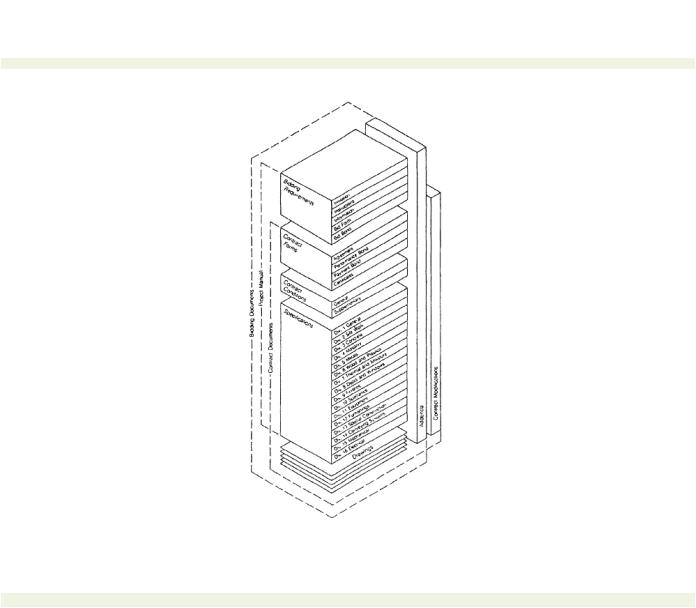
water quality and system
.pdf
< previous page |
page_205 |
next page > |
Page 205
Chapter 12
Construction
Good construction begins with good design, but good construction does not necessarily mean a good final product. It is entirely possible to do a good detailed design, write a great contract, hire an excellent contractor, finish the project on time and under budget, only to abandon the project because it does not meet the facilities' needs when complete. Good design is the result of good planning.
Planning
Planning is often the key to successful management in any facility. Unfortunately, there seems to be a severe shortfall in intelligent planning these days which leads to great frustration on the part of facility managers, staff and other professionals. Facility managers can also fall into the trap of continuous planning and not drawing planning to closure and proceeding with the next step of detailed design.
Planning at the Start
Good planning begins with goals. Successful facilities have a mission statement boldly and publicly posted for everyone to see. The goal keeps everyone focused on the mission and helps to recognize when the goal is accomplished. A simple goal for a facility water manager could be: ''Reduce costs of water maintenance by 18 percent," while another could be, "Reduce the number of
< previous page |
page_205 |
next page > |

< previous page |
page_206 |
next page > |
Page 206
customer complaints to zero." Conversely, undefined goals leave everyone without focus and intent. "Our goal: provide water to meet the needs of the facility for the upcoming programs." What programs? Goals like these are for managers to measure their own success, not the staff's.
Goals should be realistic and feasible. Without everyone buying into the goal, it is not achievable.
With goals posted, sub-elements in the organization can further define individual goals and/or subgoals. Planning to accomplish the goals begins.
Planning should start broadly to allow for measurement of present conditions and options for attainment of the goal. Some decision-makers make snap planning decisions based upon their goals, others are intuitive while still others are careful researchers. A good leader will allow his staff to participate in the planning, if there is time.
Costs of Planning
Consultants will bid the costs of planning on an hourly rate, since planning can be nebulous and can lead to some unexpected and surprising results. The facility manager should be careful not to let costs dictate his planning. All too often, planning is driven by, "Let's see, we have about $25,000 in the budget, so lets come up with a project for that amount." Obviously this type of planning and budgeting process is fraught with potential for error. The original budget is not based upon facility needs but upon available funds. The planning process, therefore, is already limited because the goals of the project are not defined.
Given planning that results from budget allocations, the results of the project will not even be measured.
Typical planning costs are shown in Table 12-1.
< previous page |
page_206 |
next page > |

< previous page |
page_207 |
next page > |
Page 207
nine percent were unheard of. Then in the early 1970s, rates and growth dramatically increased, peaking in the early 1980s at the incredible rate of 16 percent. For many facilities, the planning cycle was driven into shorter durations. The quicker something could be done, the sooner the payback could begin. Long-term payback was ignored. Seven years later, the results of these short-term projects peaked and systems and facilities began to decline at a drastic rate. It is not uncommon to see building water systems built in the 1930s outlast systems built in the late 1960s. Many water systems built in the 1970s are nearing the end of their economic life.
There are still some very old buildings, of course. Notre Dame, the famous French cathedral, was built in 1163 AD and is still used today. For its time, the most modern, ultimate construction techniques were used, and with the Church funding it, the construction budget was more or less unlimited. Doubtful the facility manager will have such good fortune today!
Once the facility manager determines the life of the project or the duration of the planning cycle, the next step, which is factoring the economics, begins. The two major economic components to be considered are cost and benefits.
Table 12-1. Project engineering and planning costs.
Long-range |
$60-$125 per hour |
planning |
|
Short-term planning$60-$125 per hour |
|
Feasibility study |
3-5% of construction costs |
Design drawings |
12-20% of construction costs |
and specifications |
|
Construction |
Depends upon size of project. Plumbing for a typical building costs $6- |
|
$8/sq.ft. of the building. |
Startup |
Depends upon the complexity of the project. For water systems, it is |
|
usually provided with the construction. Startup of equipment such as |
|
water filters or softeners is included with the price of the unit. |
< previous page page_207 next page >

< previous page |
page_208 |
next page > |
Page 208
The Three-Stage Planning Process
Planning is essentially a three-stage process stemming from goals and moving to detailed design.
Stage I - Initial planning is based upon assessment of the alternatives. Brainstorming, conceptualizing and defining scope are techniques used to come up with alternatives to meet the defined project need(s). This initial assessment is used to list all of the alternatives that meet some or possibly all of the needs.
Using this list, planners can evaluate the advantages and disadvantages of the alternative. A rough estimate of the benefits and costs is tallied. Benefits are compared to costs to highlight the more attractive alternatives. It is not so important that the costs or benefits be accurate at this stage, just that the tools used to do the estimates are the same to make a truly effective and useful comparison. Detailed work follows on the next step.
Stage 2 - From the list of all alternatives, the most attractive two or three are selected. From these, more detailed estimates are made. The first stage was an attempt to separate the more attractive alternates from the least attractive. In the second stage, costs are estimated accurately enough to request funding. At this stage, although there still is not enough detail to proceed with construction, there should be enough detail to accurately determine the costs. Estimates at this stage should be within about 20 percent of the final costs. Factors for unknowns should be added to the estimates.
Stage 3 - The final stage is where the detailed design is prepared. Several details are resolved here. The details should include the economic analysis of pumping versus pipe size (see Chapter 4). Cost of power should be checked and, if possible, future rates of power costs should be factored into the analysis. The final design would also analyze ongoing operating costs under the new system if possible.
Alternatives of pipe and tank insulation are made for a hot water system at this stage, with costs of insulation weighed against the costs of energy. Finally, costs of the alternative pipes sizes are made. Costs of seismic bracing should be included since some types of pipes require more bracing than other types. Initial pumps and tanks can be sized and cycle times and durations evaluated. From these times and cycles, costs of pumping can be weighed against the cost of tank sizes.
< previous page |
page_208 |
next page > |

< previous page |
page_209 |
next page > |
Page 209
Assessing Benefits - Facility managers usually have to look to other sources to determine the benefits of a given project.
Benefits can be tangiblethat is, their results can be directly measured in value of product sold or value of costs saved. This type of estimate should include competition prices, rate studies, marketing information and the like.
Benefits can also be intangible. Intangible benefits are those gray, undefined benefits difficult to precisely measure, such as the value of productivity among the workforce from drinking water of consistent high quality.
Intangible benefits and can become emotional issues in some cases. One example of an intangible benefit would be a "wild and free river." Obviously, there is a value to such a river but who can put a price on it? The facility manager's benefit analysis, therefore, should identify intangible benefits, even though a price cannot be directly assigned to it.
Assessing Costs - Fortunately, a dollar value for costs are much more easily determined than for benefits. The chapter on piping methods, and the chapter on equipment items both provide references for determination of costs. Elements of the project are broken down into units of labor and materials. The units are attached to unit prices and multiplied for a total cost. For planning, it is not necessary to determine the actual precise costs since the initial objective is to find the best alternative from hopefully several options.
On the cost side of project evaluation, there is risk. Estimates always contain some degree of risk. Risk can be minimized via field investigations and by checking and cross-checking the assumptions, calculations and raw data. No estimate can actually eliminate the risk, but if risks are known, decisions can be made that produce more accurate results.
One excellent source of cost data for facility managers is Cost and Price Data prepared by the R.S. Means Company. Means cost guides are prepared from public jobs bid throughout the United States. The R.S. Means guide also provides labor productivity data. For example, R.S. Means indicates that a contractor can place 350 linear feet of six-inch PVC pipe in one day. It also indicates that this work takes a crew of three men.
The planners assign priority to the projects based upon the benefits (both tangible and intangible) and the costs (including risks). It may be apparent that a large benefit can be attained at a small cost, or an alternate plan will attain a small benefit from a large cost.
< previous page |
page_209 |
next page > |

< previous page |
page_210 |
next page > |
Page 210
Ike's Approach To Cost/Benefit
During his second term as president (1956-1960), Dwight D. Eisenhower directed that western water projects seek to attain a benefit-to-cost ratio of 1:1. That is, the benefits for the projects should be as close to one as possible. If a project was beneficial, those elements of the plan that were less desirable should be added to keep it from competing with private money-making ventures and to assure that the Government's investment was paid back, but just barely.
Refining The Plan - Once the attractive options are known, planners can concentrate on the best plans. In addition, plans can be refined, and attractive ideas from one or two low-benefit projects can be included with more attractive ones. The facility manager can continue to use the analysis for future planning and can keep the plan updated.
Other Planning Approaches
There are other methods used in planning besides a pure benefits/cost analysis. These included a weighted criteria ranking system and the "murder board" approach.
Weighted Criteria Ranking - Another method consists of establishing weighted criteria for each of the planning elements. A point system is then established based upon the weighted criteria and the options with the most points become the favored alternates.
Priorities such as cleaning up the water in one building is given a point score of 6, for example, with the highest score being 10. Replacing the water softener might be given a point score of 3.
The goals are also given a value that becomes a multiplier to the point scores. Cleaning water up might be given a multiplier of 2, while for softening the multiplier might be 1.
The combination of the goals multiplied by the point score for the tasks gives a number value assigned to the objectives.
< previous page |
page_210 |
next page > |

< previous page |
page_211 |
next page > |
Page 211
out the money split in the old movie It's a Mad, Mad World.
The weighted/ranking method can be successful, however, and if the facility manager has the opportunity to try this method, it is recommended if nothing else than as a learning tool. It helps define the critical issues facing the facility.
Murder Board Approach - Another method of planning has been called the "murder board." The author is not particularly fond of this planning method, but it seems popular with top management decision-makers and so it is presented here for discussion.
The murder board is a team or group assembled to prioritize and rank proposed projects. In this approach, the facility manager or his staff will go to a regional conference or annual budget meeting. In the murder board, the manager submits his proposals to the board along with the proposals from facility managers from other locations. The tactic is for the facility managers to fight it out over the budget, in an attempt to get projects funded for their facility.
The advantage of the murder board is that the project champions are instantly and clearly defined.
Unfortunately, however, the murder board depends upon the dynamic personalities of the various facility managers or board members. Some of the rational thinking necessary to good planning gets consumed in the emotion of the board hearings. The other advantage of the murder board is that everyone knows going in there will not be enough funds to go around.
The Finish Line
Once the most attractive plan or plans has been identified, the facility manager can proceed with final planning. Final planning should determine more realistic projections of benefits and of costs. Decisions about materials of construction should be made along with a schedules for implementation. Costs of construction should be estimated and funding for the project should be located.
Design
< previous page |
page_211 |
next page > |

< previous page |
page_212 |
next page > |
Page 212
The facility should be careful not to commit to hiring any contractors at this time. Many times a facility manager becomes acquainted with one contractor, only to find that other contractors claim that fair and open competition was not sought because the facility allowed itself to become too closely aligned with one contractor too early in the process. Even if there is absolutely no truth to these allegations, if it looks funny to anyone, the facility manager is going to bear the brunt of the censure and charges.
Design Drawings
To explain the scope of work to contractors or facility construction staff, a final design is prepared. The final design consists of detailed drawings and specifications. Depending upon the complexity, the detailed drawings can be large, carefully engineered drawings, small drawings or even hand sketches. As far as the contract is concerned, there do not have to be any drawings at all. The drawings are intended to represent what is to be installed, and where, for whoever does the work. For cities and large college campuses, these drawings become part of the master record and are used later by operations and maintenance to operate and troubleshoot the system. For underground work, the location of the pipes is tied by field survey to control points. These control points can be anything from a stake in the ground to a brass monument. Design drawings show the distances from the control points to the pipe and the direction the pipe is laid. After construction, it becomes a simple matter to locate the pipes.
If pipe is being placed in a city street, for example, the design drawings should identify any other pipes also in the street and the elevations so that the contractor/builder knows where the other pipes, power lines, telephone conduits, fire hydrants, sewer manholes and all the other physical features that will be in his way during construction of the pipe.
For work inside buildings, the drawings should show elevationsi.e., what floor, and where the pipe is to be located. Along with the drawings of where the pipes are going to be placed, the drawings should provide details that show all the other information the contractor will need to know in constructing the pipes. Location of fittings, tees, ells, cleanouts, pipe utility chases, hangers and details of pipe hangers should be shown. A good engineering staff will have some experience with construction and should be able to show the contractors the information needed to prepare a bid for the work. For facility managers who do not have an engineering or planning
< previous page |
page_212 |
next page > |

< previous page |
page_213 |
next page > |
Page 213
staff, a consulting-engineering firm is best equipped to handle the requirements of final design drawings.
Depending upon the desires of the facility manager, the plan drawings may be stamped by the designer. For pipe systems, drawings may have to be stamped by a registered civil or mechanical engineer because it may be required by local building codes.
Sometimes, the designer provides notes and specifications right on the drawings and eliminates the text specifications altogether if he desires.
Final Specifications
The final specifications include written requirements for the materials of the piping, sizes, valves and fittings. The text references applicable national codes and standards and spells out the requirements for testing and coordination between various trades. The text should also reference the drawings.
A typical specification will be organized as shown in Figure 12-1, which also shows other components of the construction contract. Depending upon the complexity of the project, a detailed specification can be from 25-1,200 pages long. The extra length is for more types of materials. Each part of the detailed specifications relates to one of the parts of the project. For example, there will be a chapter on pipe. The pipe chapter will reference industry standards, materials, delivery, handling, factory tests, manufacturer certifications, quality and related work. The next chapter, which may be electrical work, would specify industry standards, wire, materials, delivery, handling, factory tests, quality and related work. As the number different types of construction are specified, the length of the contract specifications continues to grow.
Most engineering firms use standard specifications that are tailored for the individual project. The American Institute of Architects and the Construction Specifications Institute both publish standard text specifications that are edited by the designer for the specific job. In addition, the U.S. Army Corps of Engineers, the U.S. Veterans Administration, and the U.S. Naval Facilities Command each publish their own standard specifications as well. The Government Standard Specifications are in the pubic domain and can be copied without paying any fees other than the costs for copying. The standard specifications can also be directly downloaded via computer modem although fees are charged for access. (See Chapter 16 for contact information for the American Institute of Architects and the Construction Specifications Institute.)
< previous page |
page_213 |
next page > |

< previous page |
page_214 |
next page > |
Page 214
Figure 12-1.
Construction contract organization. Reprinted from: The Construction
Specifications Institute (CSI), Manual of Practice, (Figure FF/CD-4,
FF Module, 1992 edition) with permission from CSI, 1996.
< previous page |
page_214 |
next page > |
